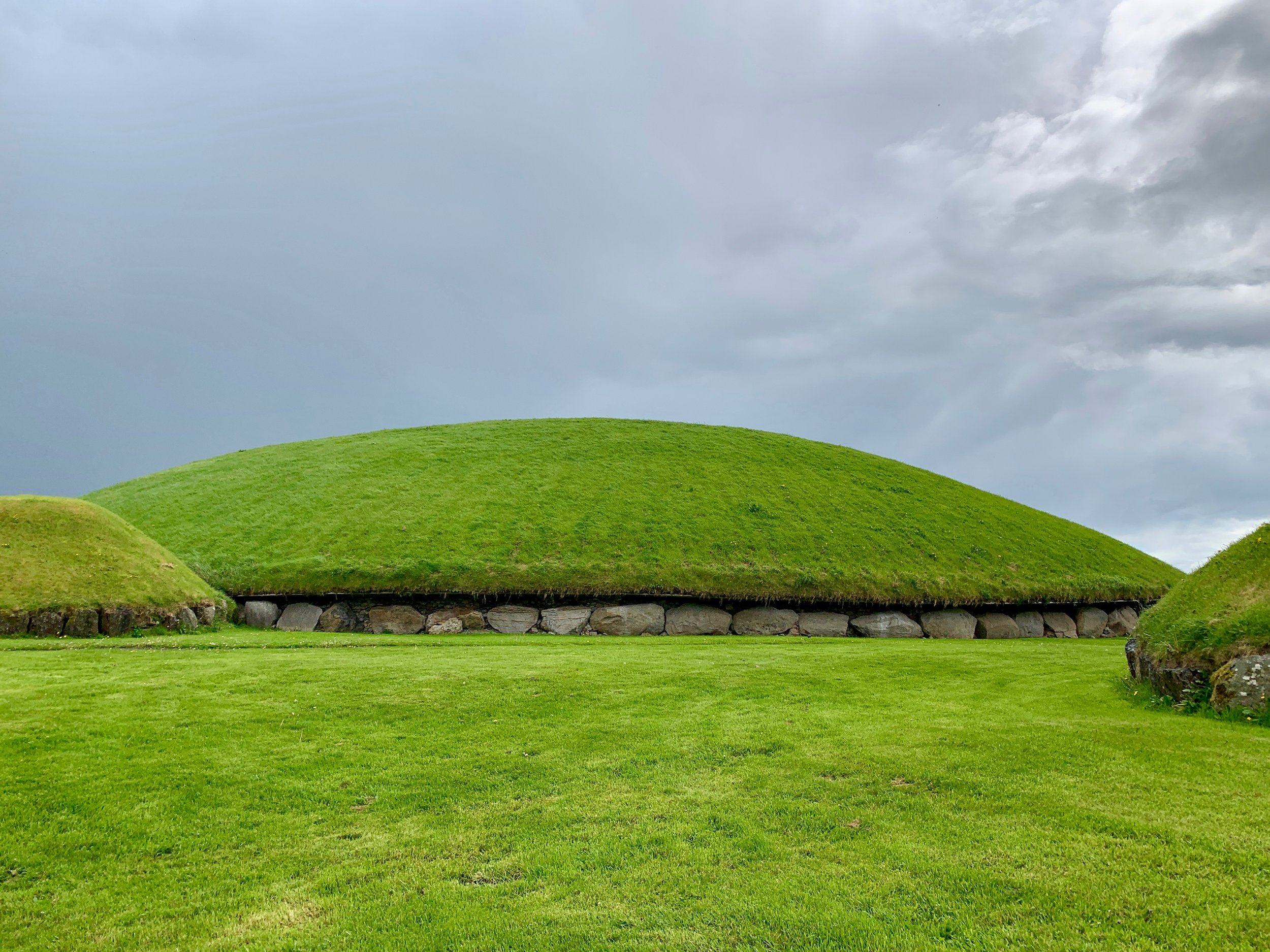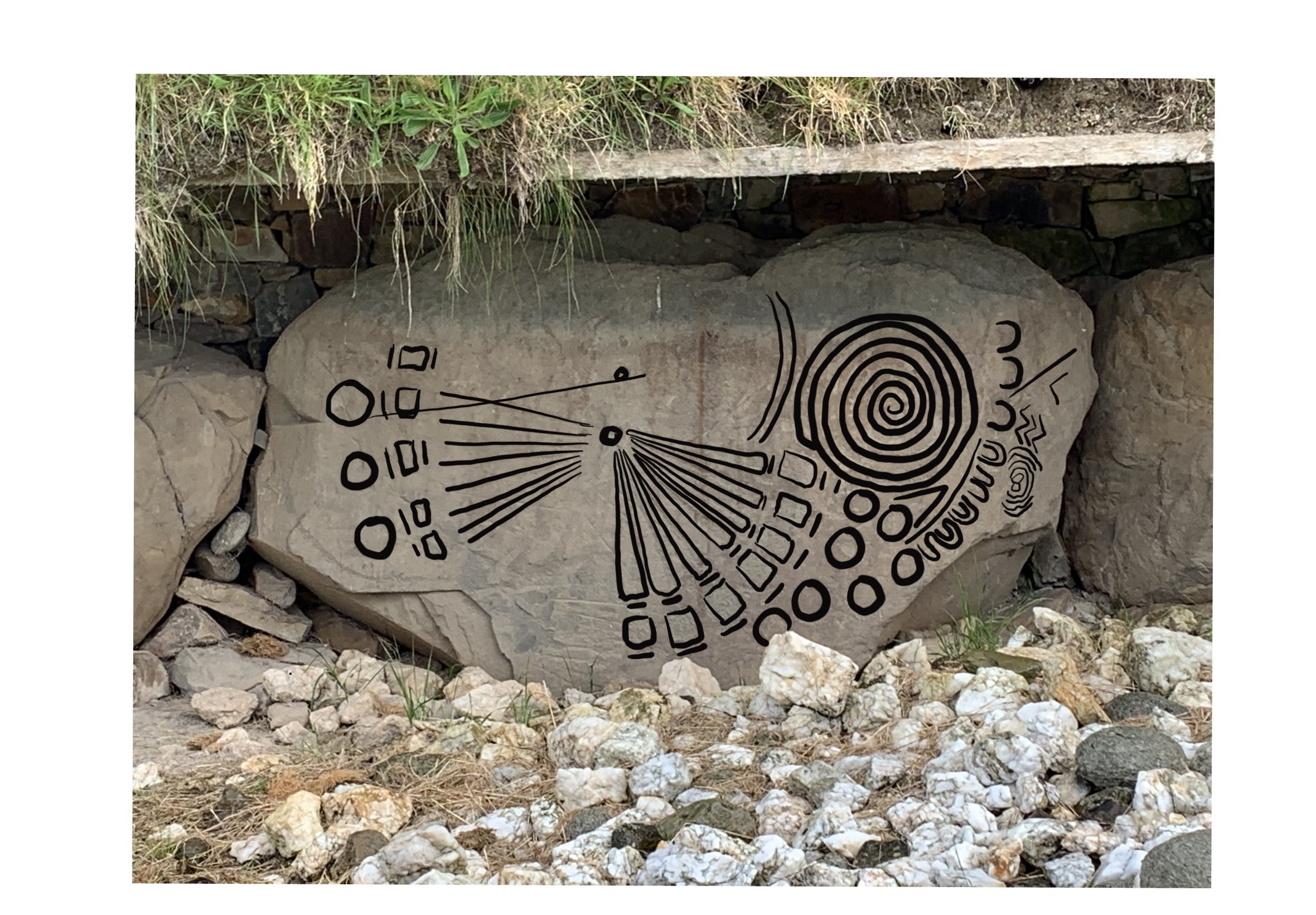EXPLORATIONS - ANCIENT ROCK ART OF KNOWTH
Stone is like a time capsule.
From a geological perspective it can tell us about its material history and the processes required to form, from a sociological perspective it can preserve information and provide clues of life from today to thousands of years ago. It’s one of the main inspirations in my artwork and I think I’ll forever be surprised and delighted by it, basically I’m stone mad!
I recently visited the prehistoric sites of Knowth and Newgrange in the Boyne Valley, Co. Meath (part of the Brú na Bóinne UNESCO World Heritage Site) wanting to explore the amazing ancient stone structures and rock art for myself. I was absolutely blown away by the sites, there was so much visual and historical information to take in and appriciate I’m going to write a separate blog specifically about Newgrange. For now let me tell you about Knowth, an awesome Megalithic passage tomb built approx 5000 years ago with the largest and most impressive examples of rock art in Ireland and Europe.
Aerial view of Knowth complex. Image courtesy of 'Boyne Valley Tours’ www.boynevalleytours.com
The Great Mound (approx 12 metres high and 67 metres in diameter) has two entrance passages on opposite western and eastern sides, with the eastern passage ending in a cruciform chamber inside. The two passages do not meet inside and were used for separate purposes. Unfortunately you can not go inside the passages for safety reasons.
Image of early excavations of the Knowth site. Image courtesy of the The Brú na Bóinne Visitor Centre
Major excavations of the Knowth complex began in 1962 by Archaeologist George Eogan and his team revealing a central Great Mound called ‘Site 1’ and 19 smaller satellite tombs surrounding it. I was just as fascinated by the excavation images as the aerial image of todays site. The systematic process which the archaeologists worked the site is impressive. The meticulous dissection of space, the removal of material to reveal history, the idea of hidden stories right beneath our feet, all of these subjects are enough to send my brain into over drive and I’ve not even begun to talk about the rock art !
Image of kerbstones that surround the Great Mound in Knowth
So lets get to it, the most striking aspect of Knowth is the shear amount of incredible rock art on display.
127 huge Kerbstones surround the central Great Mound, the majority displaying an abundance of carved symbols such as spirals, crescents, lozenges (diamond shape), cup and rings, zig zags and lines. These symbols are incredibly exciting to see in person, you can nearly sense the people that worked with the stones thousands of years ago. By marking and considering line, form, meaning and time these early creators and their guessed beliefs are brought to life.
Below are examples Kerbstone K5 (left) and K11 (right). With kerbstone K5 you can clearly see crescent and spiral shaped symbols carved into the rock. It is thought that these may represent the lunar cycle, from the waxing to full to waning moon. Kerbstone K11 at 3 metres long is the entrance stone to the Eastern passage, the central carved area of the kerbstone aligns directly with the standing stone in front of it and the passage way behind it.
In K11 image I have overlaid a drawing / trace on the photograph of the lines visible to me in an attempt to more clearly show you the symbols. Light and shadow is really important when capturing the markings and as I had a limited time during the tour I was not been able to capture all the details I would have liked. Add into the mix a typical Irish day of sporadic rain showers throughout the visit and my photography time was pretty restricted. I would love to return again and be able to stay for a longer time period to really sit with the stones and make more first hand observations.
We don’t know for sure what all these markings represent but popular guesses have connected the symbols found at Knowth to the passing of the solar and lunar phases inferring that the people who built Knowth were astrological experts of the time.
One of the most intriguing kerbstones is K15 also near the Eastern passage, thought to be a sundial or lunar chart. I’ve traced the markings below as best I can make out but there is a lot of detail missing in this image. The fanned motif does somewhat resemble a sundial though as the face of the stone (and carving ) is not sitting horizontal it would not have been able to actually function as a sundial. In regards to it being a lunar calendar perhaps this could be guessed by the appearance of segmentation of the fan shape and its corresponding circles but as with all stone art in Knowth there is no definitive confirmation of any of the theories as there is no written history from the time.
Knowth kerbstone K15 overlaid by drawing of carved symbols
Some other kerbstones that struck me as very interesting are Kerbstone K13 (left) and K86 (right), shown below with overlaid drawings of the markings.
Kerbstone K13 is full of symbols and repeating patterns, the mix of spirals, crescents, lozenges, zig zags and lines on one stone is captivating. What could this have meant? Based purely on my own personal speculation and visual interpretation I imagine seeing the meandering river Boyne represented by the snake like line in the corner, with numerous points marked out like symbols on a map, if only we could find the key to the map!
Kerbstone K86 is also intriguing, again because of repeating patterns, this time a more simplified yet strong image of mirrored crescents. Could this represent an idea of the heavens above being mirrored below?
Around the entrances to the Great Mound passage tomb are scatters of small non-local stones such as quartz, granite and banded stones. The white quartz in particular grabbed my interest with its strong contrast to the colouration of the other stones and kerb stones.
Traditionally known as cloche geala / shining stones, it is thought that in ancient Ireland quartz symbolised the sun and moon. The groupings of quartz at the east and west passages of the main Great Mound passage tomb could link to the rising and setting of the sun, in particular during the spring and fall equinoxes. Imagine how powerful the quartz glinting its brilliant white on these auspicious days in the beautiful Boyne Valley settling would have been for the people who created this ancient site.
In a way I love that it’s unknown what these symbols really mean, they are abstract, just like our understanding of prehistory, full of interpretations, instincts and of course lots of well educated guesses by expects in the area. There is so much inspiration everywhere at Knowth, I don’t think I have even really started to digest it yet and can’t wait to learn more about the site, the interior of the passages and the objects found when excavating. This is definitely inspiration for a possible future artistic project and was a great jumping off point to start my research.
Detail of quartz and granite stone scattered at the western passage entrance of Knowth’s Great Mound
If you are interested in visiting Knowth or New Grange I highly recommend you purchase ‘the Brú na Bóinne Tour + Newgrange Chamber ticket’ costing €18 per adult from The Brú na Bóinne Visitor Centre online ticket portal. It’s excellent value considering that transport is included from The Brú na Bóinne Visitor Centre to the sites and back, the knowledgeable info and insights from the wonderful guides and of course my high points the huge selection of rock art at Knowth and getting inside the chamber at New Grange.








